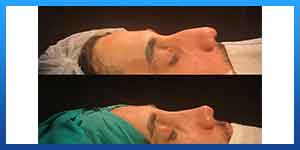Rhinoplasty Risks
The decision to undergo Rhinoplasty is extremely personal. You will have to decide if the benefits will achieve your goals and if the risks and potential complications of rhinoplasty are acceptable.
Your plastic surgeon will explain the risks associated with the surgery in detail. You will be asked to sign consent forms to ensure that you fully understand the procedure and any risks and potential complications.
Read more about Sign of infection after rhinoplasty
Read more about Rhinoplasty recovery time
Rhinoplasty surgery Risks and Side effects
What are the risks of rhinoplasty?
Rhinoplasty surgery risks include:
. Anesthesia risks
. Infection
. Poor wound healing or scarring
. Change in skin sensation (numbness or pain)
. Nasal septal perforation (a hole in the nasal septum) is rare. Additional surgical treatment may be necessary to repair the septum but it may be impossible to correct this complication.
. Difficulty breathing
. Unsatisfactory nasal appearance
. Skin discoloration and swelling
. Possibility of revision surgery
These risks and others will be fully discussed prior to your consent. It is important that you address all your questions directly with your plastic surgeon.
Read more about Rhinoplasty surgery
Read more about Rhinoplasty in Iran
Read more about Open Rhinoplasty
- Rhinoplasty in Iran
- Rhinoplasty in Iran cost
- Revision Rhinoplasty in Iran
- Closed Rhinoplasty in Iran
- Open Rhinoplasty in Iran
- Before Rhinoplasty in Iran
- During Rhinoplasty in Iran
- After Rhinoplasty in Iran
- The common methods used in rhinoplasty in Iran
- Flying after Rhinoplasty in Iran
- Risks of Rhinoplasty in Iran
- Steps of Rhinoplasty in Iran
- Cleaning outside of nose after Rhinoplasty in Iran
- Best age for Rhinoplasty surgery
- Rhinoplasty Recovery
- Features of a good Rhinoplasty surgery in Iran
- Infective complications related to Rhinoplasty surgery
- Plastic surgery in Iran
- Rhinoplasty
- Face lift
- Facial plastic surgery
- Lip augmentation
- Ear pinning
- Blepharoplasty
- Neck lift surgery
- Chin lift surgery
- Liposuction
- Abdominoplasty (tummy tuck)
- Body sculpting
- Arm Lift
- Brazilian Butt Lift
- Breast Augmentation
- Breast Lift
- Breast implant
- male breast reduction ( gynecomastia )
- sex reassignment surgery ( sex change )
- Vaginoplasty
- labiaplasty
- Hair transplant for male
- Female hair transplant
- Reconstructive surgery
- Septoplasty
- Breast reconstruction
- Breast reduction
- Cleft lip and palate repair






